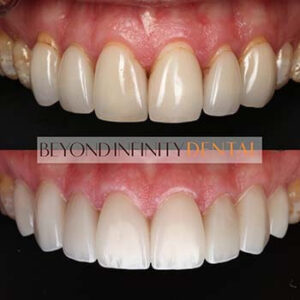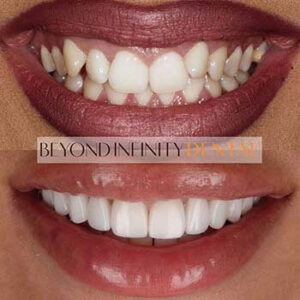Patients often ask, “how are veneers applied?”
It’s a reasonable question for anyone considering a smile makeover, and as with any cosmetic dentistry procedure, it’s always best to carry out your research first.
So, what are dental veneers exactly?
Dental veneers are overlays for the front surface of the teeth designed to conceal any imperfections and improve the overall impression of your smile.
 If teeth are uneven or chipped, slightly crooked or gapped, or discoloured and non-responsive to chemical whitening treatments, then veneers could be the perfect fit for you.
If teeth are uneven or chipped, slightly crooked or gapped, or discoloured and non-responsive to chemical whitening treatments, then veneers could be the perfect fit for you.
Porcelain veneers are the most common type of veneer, although many dental clinics also offer composite veneers.
Porcelain veneers are durable and robust, and because they possess similar translucent properties to tooth enamel, they create an incredibly natural-looking smile.
While composite veneers achieve similar results, they do not last as long and are more prone to staining.
How do dental veneers look?
When applied well, veneers look like your natural teeth, only better! They are an ideal solution for someone who hasn’t got extensive damage but wants a perfect smile in a relatively non-invasive manner.
Here at Beyond Infinity Dental, Dr Jack Yang customises bespoke veneers to give patients a beautiful smile that is even and symmetrical. Personalised to meet specific needs, our cosmetic dental veneers offer a permanent way of achieving a smile you’ll love.
So, how are veneers applied?
The process of having dental veneers applied is relatively straightforward. Following an initial consultation, usually, only two visits to the clinic are required. Once the dentist has fitted your veneers, you will still need to schedule regular visits with a hygienist to stay on track with your oral health.
Creating a treatment plan
The first stage of the dental veneers procedure is to create a treatment plan. We will commence by assessing your pearly whites and taking some x-rays to determine that veneers are a suitable treatment for you. Also, we will check to ensure that you have no underlying oral health conditions.
If you do have underlying conditions you may need to undergo additional treatments before we can go ahead with fitting your veneers, or it may be that a different treatment may be better for the result you are hoping to achieve.
Dr Jack Yang believes in involving patients at the outset of their cosmetic dentistry treatment.
Thanks to innovative digital smile design software, we can give you an on-screen peep of how your smile will look before we commence treatment. We also find this helps patients better communicate their desired outcome.
There’s no need to cover every tooth, only the problematic ones and possibly the neighbouring teeth. Dr Yang can help you decide how many veneers you need to achieve the best possible outcome.
Most people choose to veneer the teeth in their smile line, either on the top, bottom or both arches, as these are most visible.
However, our skilled dentist can piece in individual dental veneers if your smile is pretty much how you want it, almost like slotting a piece into a jigsaw puzzle. Each veneer will be customised and shade-matched to your existing teeth for a seamless look.
Once your treatment plan is in place, it’s time to discuss your veneer options, including their size, shape, and colour, to ensure a natural-looking, beautiful smile.
So, let’s get back to how veneers are applied.
Preparation
Having decided on your porcelain veneers, our dentist will prepare your teeth for the treatment.
The first step is to remove a thin layer of tooth enamel from the tooth’s surface. The amount of enamel removed is determined by the thickness of the veneer that replaces it. This way, the veneer fits seamlessly into the smile without appearing bulky and enhances the natural look. Removing what is usually between 0.3 and 0.5 mm of enamel helps preserve the tooth root, makes sure the veneered teeth last a long time and ensures there are few if any issues if replacing them at a later date in the future.
The next step is to create a digital impression of the prepared tooth. The mould is sent to our lab, where experienced technicians carefully make your bespoke new porcelain veneers.
Applying your dental veneers
The final step of the procedure is to fit your veneers. First, our dentist will roughen, clean and polish the surface of the tooth.
 Doing so helps create a stronger bond between the tooth and the veneer. A special adhesive is applied to the tooth’s surface before the veneer is placed on top. A high-intensity light is then shone on the tooth to help the adhesive harden quickly.
Doing so helps create a stronger bond between the tooth and the veneer. A special adhesive is applied to the tooth’s surface before the veneer is placed on top. A high-intensity light is then shone on the tooth to help the adhesive harden quickly.
Before you leave, our dentist will assess your bite and make necessary adjustments to ensure you are happy with how your porcelain veneers look and feel.
So, that’s how porcelain veneers are applied.
However, if budget is key, you might want to consider composite veneers since they are a cheaper option.
How are composite veneers applied?
Our dentist uses composite resin and applies it to the tooth’s surface. Yes, the same material that makes up white tooth fillings. The dentist then shapes, smoothes and hardens the resin to create a new long-lasting tooth surface. Since we can apply composite veneers in just one appointment, you can leave our clinic with a brand new smile the very same day.
Advantages of dental veneers
One of the main advantages of veneers is that they are relatively non-invasive, and with care, porcelain veneers can last as long as 15 years before they need replacing. Composite veneers will last between 4 and 8 years.
Get in touch
Hopefully, this article has answered your question, “how are veneers applied?” If you want to learn more about dental veneers and find out if they are an option for you, why not schedule a consultation with the experienced team at Beyond Infinity Dental. We now offer the National Dental Plan financing solution to help you spread the cost of cosmetic dentistry.
Call us today on (02) 8806 3799 or use our online booking service. We look forward to meeting you.









